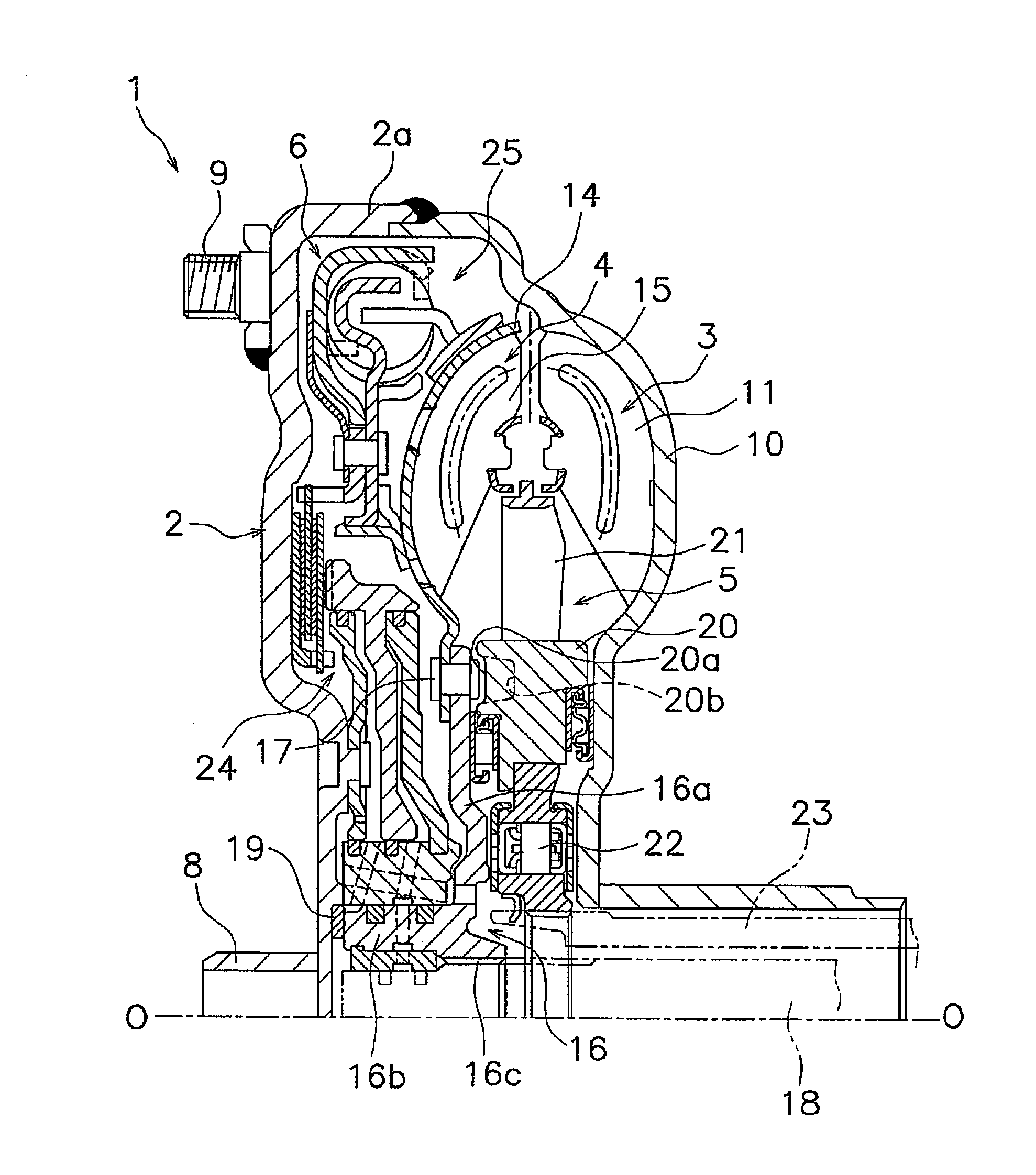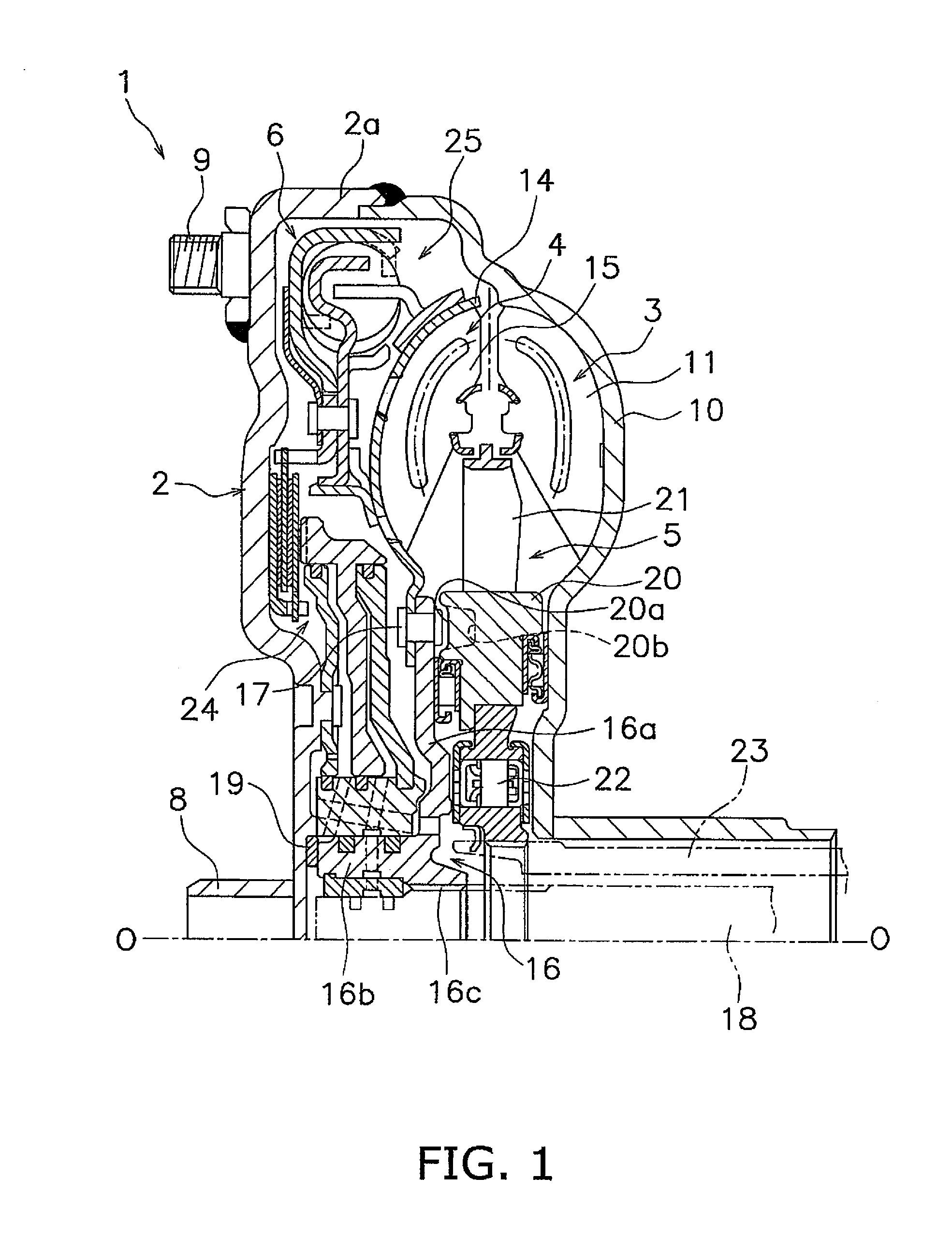Lock-up device for torque converter
- Summary
- Abstract
- Description
- Claims
- Application Information
AI Technical Summary
Benefits of technology
Problems solved by technology
Method used
Image
Examples
first exemplary embodiment
Entire Structure of Torque Converter
[0036]FIG. 1 is a vertical cross-sectional view of a torque converter 1 employing an exemplary embodiment of the present invention. The torque converter 1 is a device for transmitting torque from a crankshaft of an engine to an input shaft of a transmission. In FIG. 1, the engine (not illustrated in the drawing) is disposed on the left side, whereas the transmission (not illustrated in the drawing) is disposed on the right side. A line O-O depicted in FIG. 1 indicates a rotary axis of the torque converter 1.
[0037]The torque converter 1 mainly includes a front cover 2, a torque converter main body composed of three types of vane wheels (an impeller 3, a turbine 4 and a stator 5), and a lock-up device 6.
[0038]The front cover 2 is a disc-shaped member that a center boss 8 is fixed to the inner peripheral end thereof by welding. The center boss 8 is a cylindrical member extending in the axial direction, and is inserted into a center hole bo...
second exemplary embodiment
[0092]FIG. 8 illustrates another exemplary embodiment of a power transmission plate support member. This power transmission plate support member 70 is composed of a first plate 71 and a second plate 72.
[0093]The first plate 71 is formed in an annular shape, and is composed of a fixation portion 71a, an first axial restriction portion 71b, a radial restriction portion 71c and a second plate support portion 71d. The structures of the fixation portion 71a, the first axial restriction portion 71b and the radial restriction portion 71c are the same as those of the fixation portion 68a, the first axial restriction portion 68b and the radial restriction portion 68c in the power transmission plate support member 68 of the first exemplary embodiment. The second plate support portion 71d is formed by bending the radial restriction portion 71c to the inner peripheral side.
[0094]The second plate 72 is formed in a disc shape, and the inner peripheral part thereof is fixed to the second plate sup...
third exemplary embodiment
[0096]FIG. 9 illustrates another exemplary embodiment of the structure for moving the piston. In this exemplary embodiment, a piston support member 75 is mounted to the outer peripheral surface of a tubular portion 16b′of a turbine hub 16′.
[0097]The piston support member 75 is disposed between the front cover 2 and the turbine 4, and is composed of: a disc portion 75a functioning as a plate composing a part of a lock-up oil chamber; and a tubular portion 75b. The outer peripheral part of the disc portion 75a extends to reach the first clutch plate 28 and the second clutch plate 29. The tubular portion 75b extends from the inner peripheral end part of the disc portion 75a toward the front cover 2. The tubular portion 16b′ of the turbine hub 16′ is inserted into the inside of the tubular portion 75b. Further, the tip end of the tubular portion 75b is fixed to the front cover 2 by welding or so forth.
[0098]A piston 30′ is disposed between the front cover 2 and the disc portion 75a of t...
PUM
 Login to View More
Login to View More Abstract
Description
Claims
Application Information
 Login to View More
Login to View More - R&D
- Intellectual Property
- Life Sciences
- Materials
- Tech Scout
- Unparalleled Data Quality
- Higher Quality Content
- 60% Fewer Hallucinations
Browse by: Latest US Patents, China's latest patents, Technical Efficacy Thesaurus, Application Domain, Technology Topic, Popular Technical Reports.
© 2025 PatSnap. All rights reserved.Legal|Privacy policy|Modern Slavery Act Transparency Statement|Sitemap|About US| Contact US: help@patsnap.com



